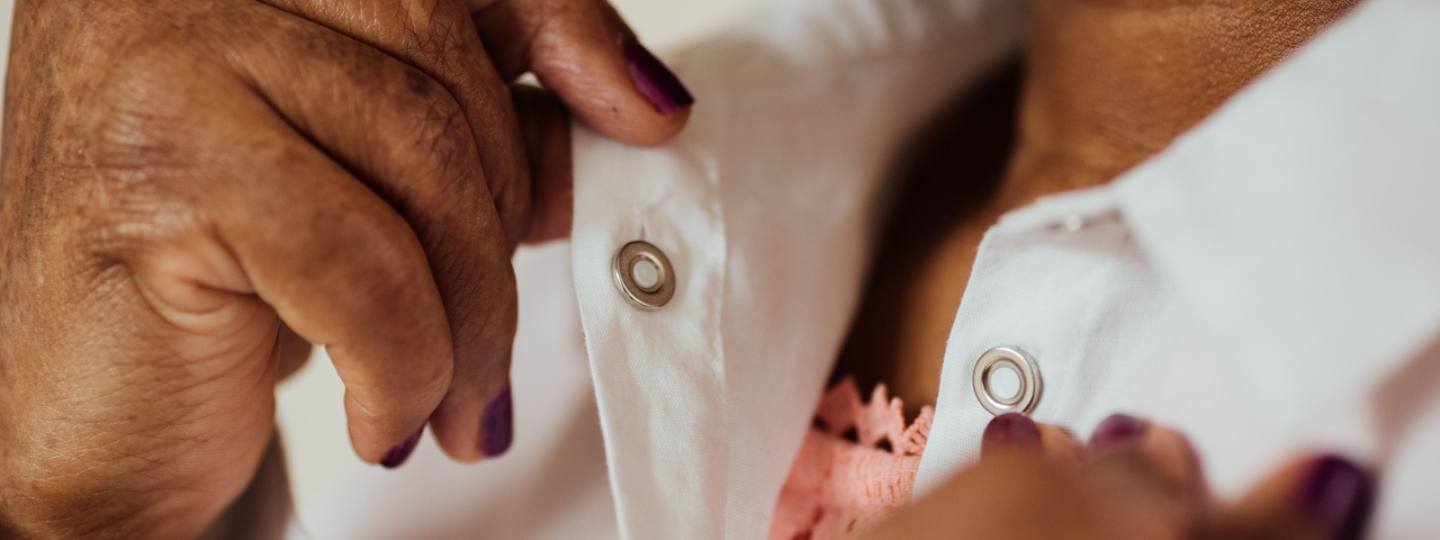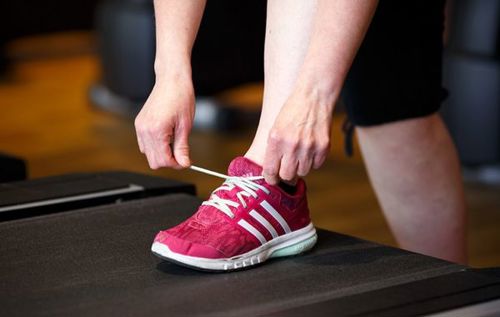Getting dressed with arthritis: Tips to make it easier
18 January 2024
Putting on clothes can quickly become a frustrating task when you’re living with arthritis.
We know that using fiddly buttons can be exasperating if your fingers feel stiff or achy. And, if you have poor balance or mobility, putting on trousers or socks might be a little challenging at times.
But there are small ways you can make getting dressed a bit easier. You deserve to wear clothes that make you feel good.
Here Christina MacLeod, Occupational Therapist, shares her tips for getting dressed if you have arthritis. An occupational therapist is a healthcare professional who can help you carry out everyday tasks, maintain your independence and doing the things you enjoy.
Choose loose clothing
A simple way you can make dressing easier is by buying looser clothing. This will make it easier to put on and take off your clothes.
“When shopping for clothes, it’s worth picking looser-fitting or slightly larger sizes,” explains Christina. “For trousers or skirts, it might also be worth buying clothes that have an elasticated waist. Just check the elastic isn’t too tight. They’ll be easier to pull on and off.
“Avoid tight fitting underwear and socks too. And if you wear tights, it might also be helpful to buy single leg tights.”
“It’s about buying fashionable clothes that you like, but which are easier to put on.”
Dealing with buttons and zips
Buttoning clothes can be frustrating if you have sore or painful fingers. If this is something you struggle with, Christina says:
- You might also want to buy clothes that don’t have a lot of buttons, if that’s something you find challenging.
- You could use a button hook. This is an aid which you can use to guide any button through a buttonhole.
- Some people prefer to buy clothes which have Velcro or snap button fastenings instead.
If you find zips difficult, Christina recommends:
- Putting a small piece of material through the tag, which might make it easier to pull the zip up and down.
- Using zipper aids, if you struggle to grasp the zip.
- Leaving your clothing unzipped if you’d prefer.
- Leaving your clothes partially zipped and pulling them over your head.
- Add magnetic zippers to your clothes.
- Avoid back fastenings.
- Using back fastening can be a challenge at the best of times. So, it might be worth avoiding them if you can.
Alternatively, you could try to fasten your clothes at the front and twist them around your body if this is easier. For people who wear bras, Christina recommends:
- Purchasing bras that fasten at the front.
- Replacing hooks with Velcro.
- Wearing tops that offer bra support instead.
Choose comfortable shoes
 Most people will experience pain in and around their feet at some point in their lives. But if you have arthritis, you might be more prone to foot problems.
Most people will experience pain in and around their feet at some point in their lives. But if you have arthritis, you might be more prone to foot problems.
The good news is there are plenty of ways we can look after our feet, from wearing comfortable, fitting shoes to make footcare a daily habit.
Want to buy some new shoes? It might be worth buying a pair which:
- Have a sturdy sole.
- Fit comfortably and have a roomy toe box. This is the part of the shoe which surrounds your toes.
- Picking shoes that have a removable insole if you wear orthotics, such as insole or splints. That way, you can put your own orthotics in, without making the shoe too tight.
If you struggle tying your shoelaces, Christina recommends:
- Choosing shoes that have Velcro fastenings.
- Choosing shoes which have elastic, draw-string laces (such as triathlon trainers).
- Using coiled shoelaces.
- Using a long-handled shoehorn to help you put on your shoes.
Use aids and adaptations.
From shoehorns to button fasteners, there are plenty of aids and adaptations that might make dressing a little easier.
“If you’re putting on a cardigan, for example, you might find it helpful to use a dressing stick. This aid can make it easier to pull clothing over your shoulders,” says Christina.
Aids and adaptations can be expensive. But you may be eligible to get aids and minor adaptations (worth less than £1,000) for free from your local council. This is sometimes called ‘community equipment.’
To check if you’re eligible, simply ask your council for a free needs assessment.
Spread the load
Joint protection, sometimes called ‘joint care,’ is about making small changes to the way you do things so that you reduce the pain and strain on your joints. When getting dressed, for example, it can help to use stronger joints where you can.
“If you struggle to grip trousers when pulling them up, for example, it sometimes helps to put your hands in your pocket, make a fist, and then pull up your trousers using the pockets,” says Christina.
Simple planning
If you have trouble balancing, why not sit down and get dressed when putting your clothes on?
When putting on a coat or cardigan, you could even lay the coat open on the back of a chair, sit down, and put it on while sat down. Planning your outfits for the following day might make your mornings a little less hectic too.
Laundry
If you find doing the laundry challenging, you might find it useful to:
- Do smaller loads of laundry, as this will put less strain on your arms.
- Using a cart with wheels to help you carry your laundry basket.
- Skip ironing where possible.
- Using aids, such as a grabber, to avoid bending when taking laundry out of the washing machine.
- Asking your family to help.
"Whenever purchasing anything, it’s worth trying before you buy. Everyone’s different, so it’s about finding what works for you."
Ask your family to help
Despite the aids and strategies, there might be times when you just need a hand getting dressed – and that’s okay. Let your family help you, but why not explain what that looks for you, so you feel more in-control.
We’re here for you
If you need advice or support, remember you can:
- Call our free helpline on 0800 5200 520 .
- Chat to our Arthritis Virtual Assistant.
- Join our online community.
- Stay in touch and follow us on X (Twitter), Facebook and Instagram.